Abstract
1. The production of heat (h) and work (w) and the changes in phosphocreatine (PCr) and ATP have been measured on tetanized isolated frog muscles (unpoisoned and in oxygen at 0° C) during shortening at constant velocity and during isometric contraction (both without relaxation). The former type of contraction was designed to maximize the fraction w/(h + w); the latter to minimize it.
2. The duration of the isometric contraction was made considerably longer than that of the isovelocity contraction so that the (h + w) productions during the two contractions were approximately equal.
3. The PCr break-down during the working contraction was considerably greater than that during the isometric contraction.
4. No detectable ATP changes occurred.
5. The break-down of PCr is sufficient to account for the work evolved: there is no reason to suppose that the work comes from an unidentified source.
6. In both types of contraction extra energy is evolved that cannot be accounted for by concurrent splitting of PCr. The time course of evolution of this extra energy is similar in all types of contraction, suggesting that it may arise from a process other than cross-bridge interaction.
7. The results are discussed in terms of current cross-bridge theory and muscle kinetics. The mean cycle times of a cross-bridge during working and isometric contractions are 0·12 sec and 0·34 sec respectively. During the working contraction cross-bridges spend about one quarter of the time attached to actin filaments.
Full text
PDF
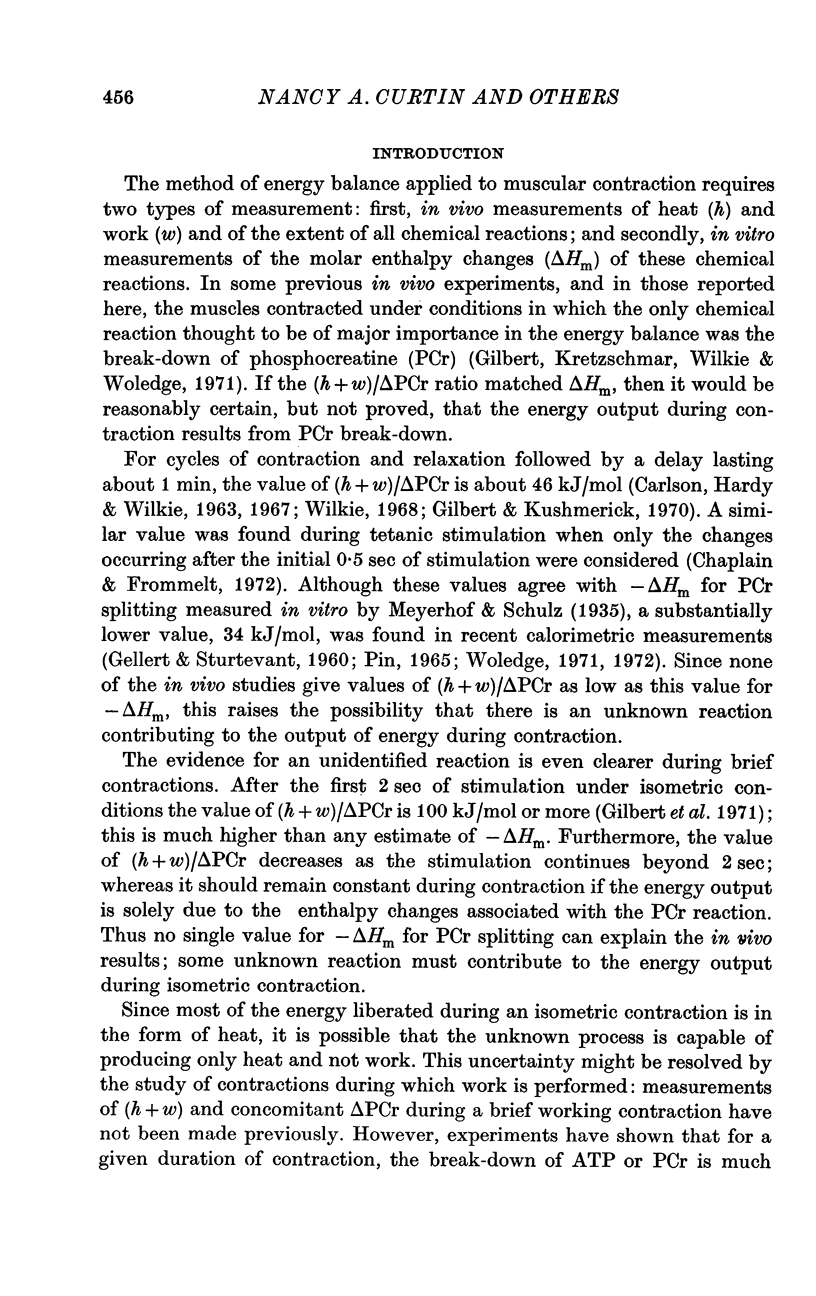





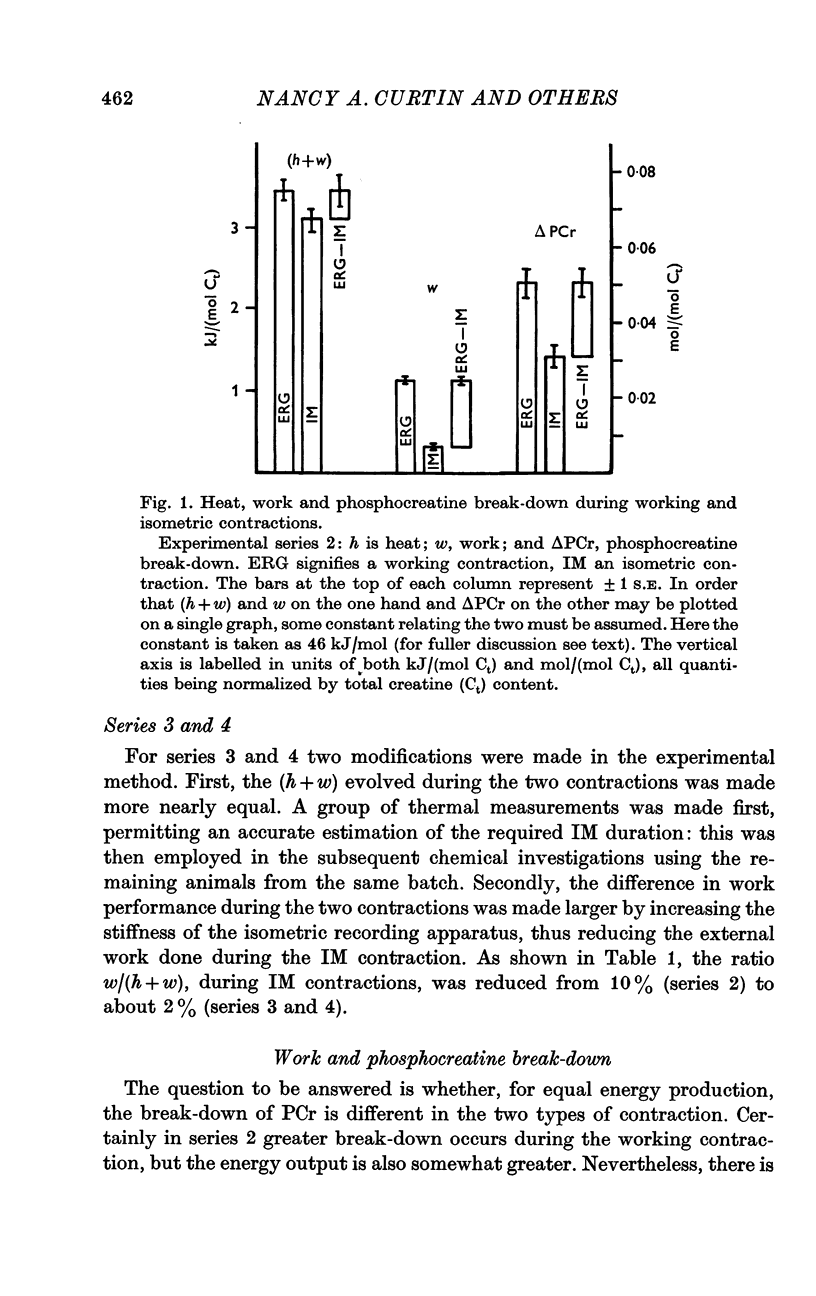




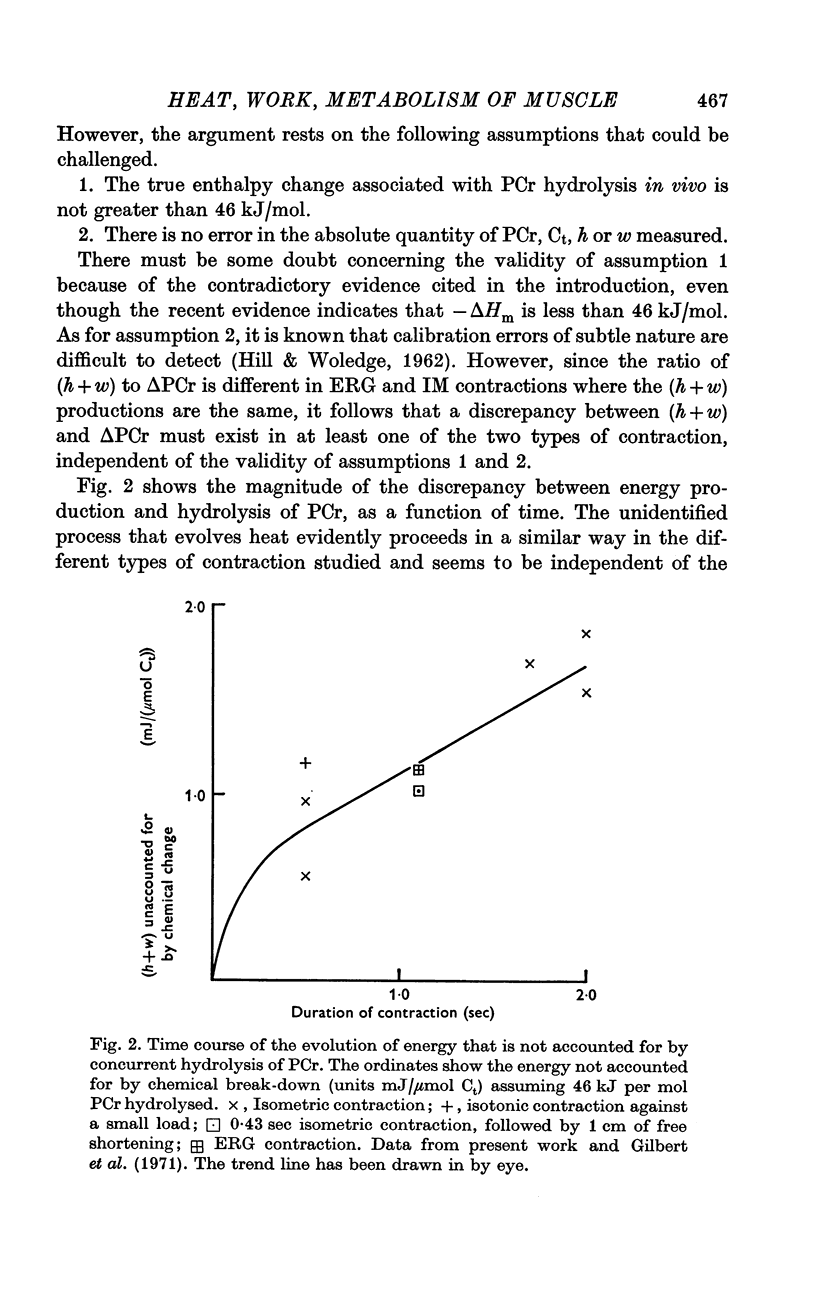
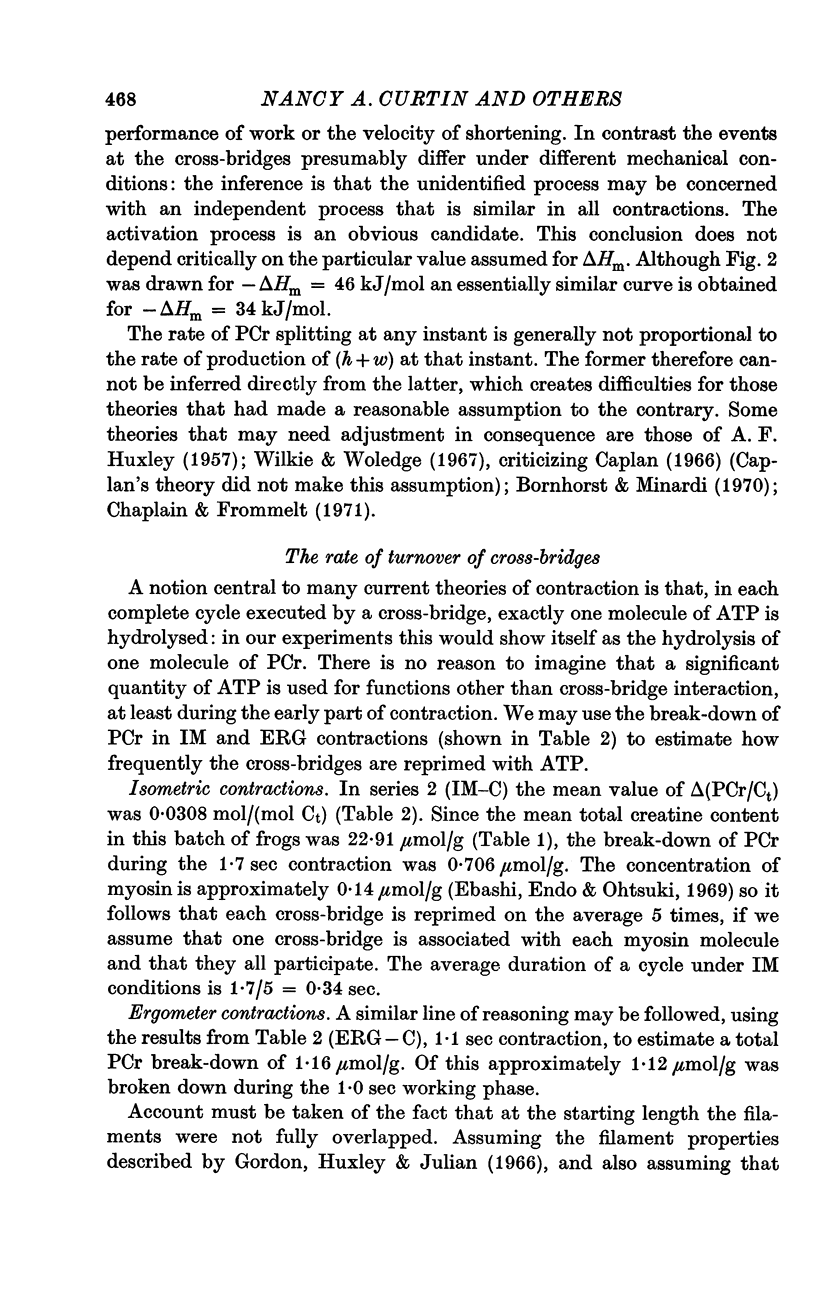


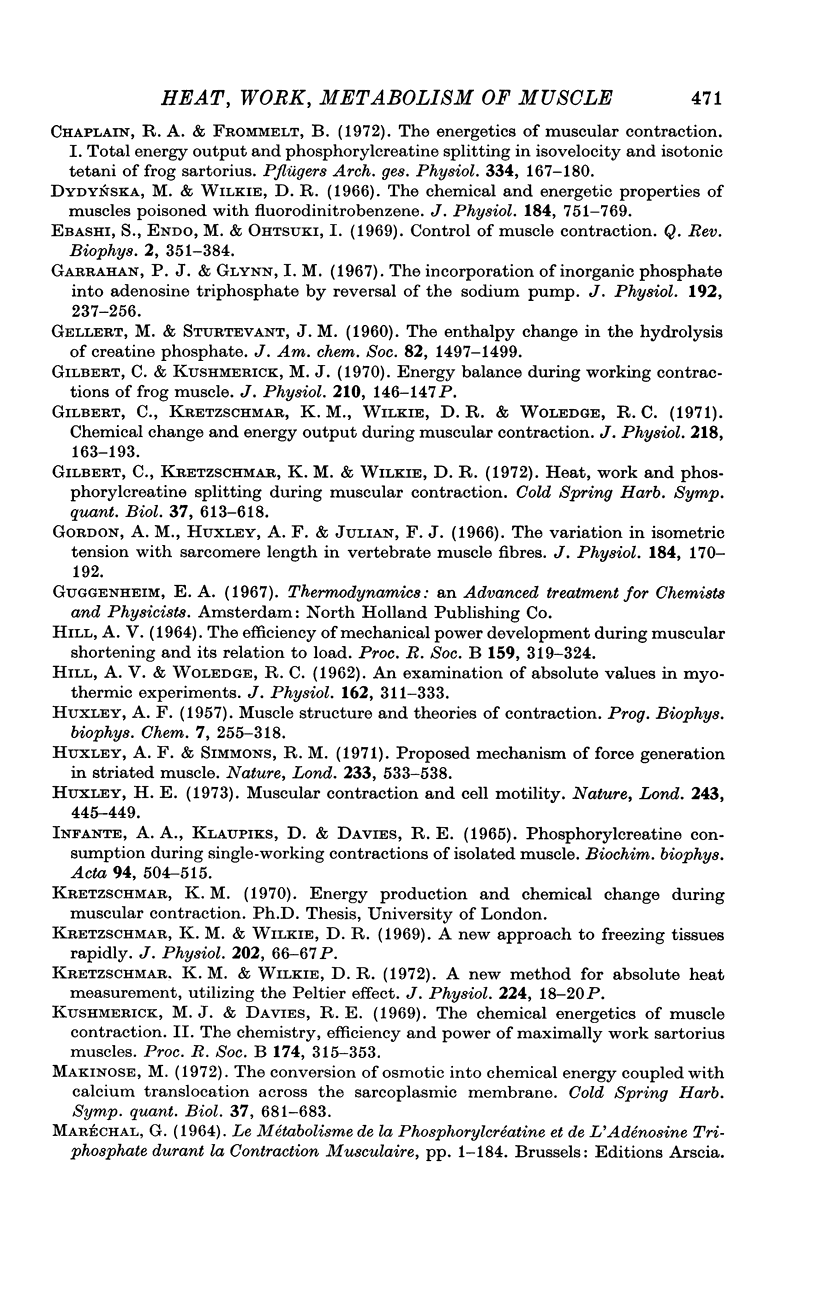

Selected References
These references are in PubMed. This may not be the complete list of references from this article.
- Bornhorst W. J., Minardi J. E. A phenomenological theory of muscular contraction. I. Rate equations at a given length based on irreversible thermodynamics. Biophys J. 1970 Feb;10(2):137–154. doi: 10.1016/S0006-3495(70)86290-7. [DOI] [PMC free article] [PubMed] [Google Scholar]
- CARLSON F. D., HARDY D. J., WILKIE D. R. Total energy production and phosphocreatine hydrolysis in the isotonic twitch. J Gen Physiol. 1963 May;46:851–882. doi: 10.1085/jgp.46.5.851. [DOI] [PMC free article] [PubMed] [Google Scholar]
- CARLSON F. D., SIGER A. The creatine phosphoryltransfer reaction in iodoacetate-poisoned muscle. J Gen Physiol. 1959 Nov;43:301–313. doi: 10.1085/jgp.43.2.301. [DOI] [PMC free article] [PubMed] [Google Scholar]
- Caplan S. R. A characteristic of self-regulated linear energy converters. The Hill force-velocity relation for muscle. J Theor Biol. 1966 May;11(1):63–86. doi: 10.1016/0022-5193(66)90040-3. [DOI] [PubMed] [Google Scholar]
- Carlson F. D., Hardy D., Wilkie D. R. The relation between heat produced and phosphorylcreatine split during isometric contraction of frog's muscle. J Physiol. 1967 Apr;189(2):209–235. doi: 10.1113/jphysiol.1967.sp008164. [DOI] [PMC free article] [PubMed] [Google Scholar]
- Chaplain R. A., Frommelt B. The energetics of muscular contraction. I. Total energy output and phosphoryl creatine splitting in isovelocity and isotonic tetani of frog sartorius. Pflugers Arch. 1972;334(2):167–180. doi: 10.1007/BF00586789. [DOI] [PubMed] [Google Scholar]
- Dydyńska M., Wilkie D. R. The chemical and energetic properties of muscles poisoned with fluorodinitrobenzene. J Physiol. 1966 Jun;184(3):751–769. doi: 10.1113/jphysiol.1966.sp007946. [DOI] [PMC free article] [PubMed] [Google Scholar]
- Ebashi S., Endo M., Otsuki I. Control of muscle contraction. Q Rev Biophys. 1969 Nov;2(4):351–384. doi: 10.1017/s0033583500001190. [DOI] [PubMed] [Google Scholar]
- Garrahan P. J., Glynn I. M. The incorporation of inorganic phosphate into adenosine triphosphate by reversal of the sodium pump. J Physiol. 1967 Sep;192(1):237–256. doi: 10.1113/jphysiol.1967.sp008298. [DOI] [PMC free article] [PubMed] [Google Scholar]
- Gilbert C., Kretzschmar K. M., Wilkie D. R., Woledge R. C. Chemical change and energy output during muscular contraction. J Physiol. 1971 Oct;218(1):163–193. doi: 10.1113/jphysiol.1971.sp009609. [DOI] [PMC free article] [PubMed] [Google Scholar]
- Gilbert C., Kushmerick M. J. Eenergy balance during working contractions of frog muscle. J Physiol. 1970 Sep;210(2):146P–147P. [PubMed] [Google Scholar]
- Gordon A. M., Huxley A. F., Julian F. J. The variation in isometric tension with sarcomere length in vertebrate muscle fibres. J Physiol. 1966 May;184(1):170–192. doi: 10.1113/jphysiol.1966.sp007909. [DOI] [PMC free article] [PubMed] [Google Scholar]
- HILL A. V. THE EFFICIENCY OF MECHANICAL POWER DEVELOPMENT DURING MUSCULAR SHORTENING AND ITS RELATION TO LOAD. Proc R Soc Lond B Biol Sci. 1964 Jan 14;159:319–324. doi: 10.1098/rspb.1964.0005. [DOI] [PubMed] [Google Scholar]
- HILL A. V., WOLEDGE R. C. An examination of absolute values in myothermic measurements. J Physiol. 1962 Jul;162:311–333. doi: 10.1113/jphysiol.1962.sp006935. [DOI] [PMC free article] [PubMed] [Google Scholar]
- HUXLEY A. F. Muscle structure and theories of contraction. Prog Biophys Biophys Chem. 1957;7:255–318. [PubMed] [Google Scholar]
- Huxley A. F., Simmons R. M. Proposed mechanism of force generation in striated muscle. Nature. 1971 Oct 22;233(5321):533–538. doi: 10.1038/233533a0. [DOI] [PubMed] [Google Scholar]
- Huxley H. E. Muscular contraction and cell motility. Nature. 1973 Jun 22;243(5408):445–449. doi: 10.1038/243445a0. [DOI] [PubMed] [Google Scholar]
- INFANTE A. A., KLAUPIKS D., DAVIES R. E. PHOSPHORYLCREATINE CONSUMPTION DURING SINGLE-WORKING CONTRACTIONS OF ISOLATED MUSCLE. Biochim Biophys Acta. 1965 Mar 29;94:504–515. doi: 10.1016/0926-6585(65)90059-2. [DOI] [PubMed] [Google Scholar]
- Kretzschmar K. M., Wilkie D. R. A new approach to freezing tissues rapidly. J Physiol. 1969 Jun;202(2):66P–67P. [PubMed] [Google Scholar]
- Kushmerick M. J., Davies R. E. The chemical energetics of muscle contraction. II. The chemistry, efficiency and power of maximally working sartorius muscles. Appendix. Free energy and enthalpy of atp hydrolysis in the sarcoplasm. Proc R Soc Lond B Biol Sci. 1969 Dec 23;174(1036):315–353. doi: 10.1098/rspb.1969.0096. [DOI] [PubMed] [Google Scholar]
- MOMMAERTS W. F., SERAYDARIAN K., MARECHAL G. Work and chemical change in isotonic muscular contractions. Biochim Biophys Acta. 1962 Feb 12;57:1–12. doi: 10.1016/0006-3002(62)91071-5. [DOI] [PubMed] [Google Scholar]
- Moore P. B., Huxley H. E., DeRosier D. J. Three-dimensional reconstruction of F-actin, thin filaments and decorated thin filaments. J Mol Biol. 1970 Jun 14;50(2):279–295. doi: 10.1016/0022-2836(70)90192-0. [DOI] [PubMed] [Google Scholar]
- Wilkie D. R. Heat work and phosphorylcreatine break-down in muscle. J Physiol. 1968 Mar;195(1):157–183. doi: 10.1113/jphysiol.1968.sp008453. [DOI] [PMC free article] [PubMed] [Google Scholar]


